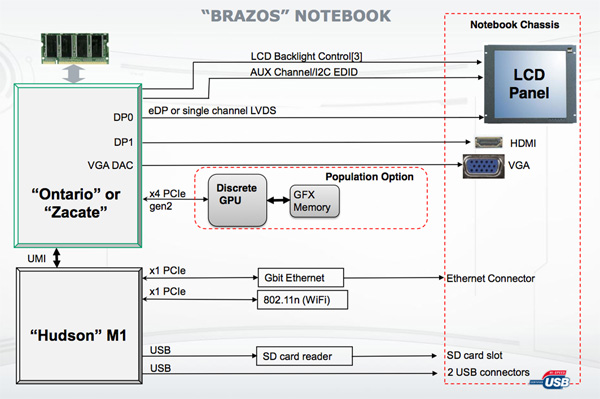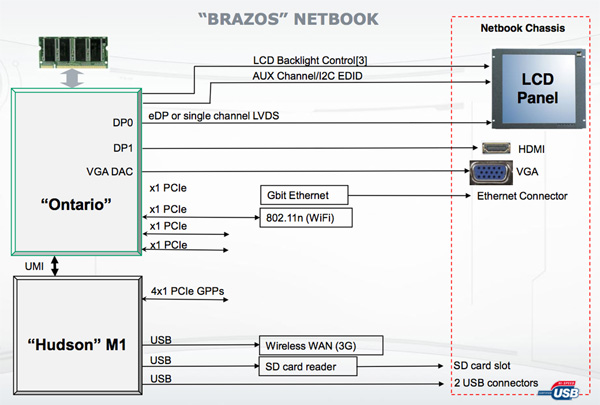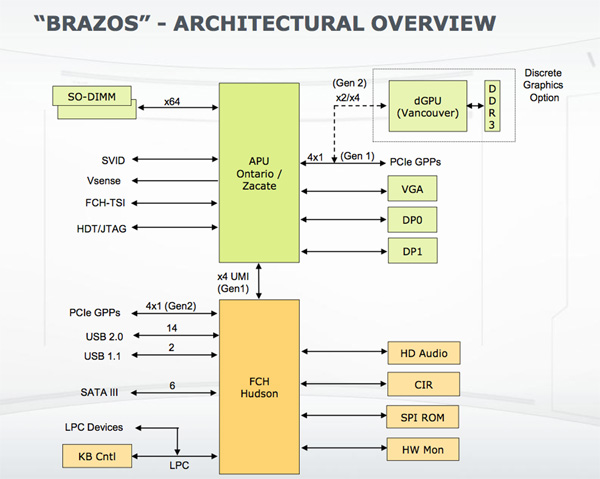Previewing AMD's Brazos, Part 1: More Details on Zacate/Ontario and Fusion
by Anand Lal Shimpi on November 9, 2010 1:09 AM ESTThe Chipset err...Fusion Controller Hub
The Zacate/Ontario APUs have an integrated PCIe interface sporting 8 lanes. Four of those lanes are used for AMD’s Universal Media Interface (UMI) - a bus that links the APU to the Hudson FCH. The remaining four can be used for discrete graphics or a combination of discrete graphics and other PCIe controllers. Both PCIe interfaces can run at gen 1 or gen 2 transfer rates.
Display output naturally stems off of the APU. You can drive two displays in tandem over any combination of VGA or Display Port/DVI/HDMI/LVDS.
As I mentioned earlier, the APU sports a single channel memory controller - but you can install up to two DIMMs on that channel. Speeds are down from the 1333MHz system we tested at IDF, DDR3-1066 is the max you’ll officially see on a Brazos system.
The Hudson FCH supplies up to 14 USB 2.0 ports, 6 x 6Gbps SATA ports and another 4 PCIe lanes. The FCH is based on AMD’s SB800 series of South Bridges. Despite the small size, this is a full featured platform.
From the looks of it, AMD has all of the right ingredients for some very competitive entries in the mainstream and ultraportable notebook markets. Now it’s just up to the OEMs to build something cool out of it.
Check back in about a week for the full rundown on Zacate performance.













106 Comments
View All Comments
Dark_Archonis - Wednesday, November 10, 2010 - link
You're right, and as I said, the iPad is likely not the ONLY cause.However, the fact remains that netbook sales are collapsing and I don't see them improving.
mino - Thursday, November 11, 2010 - link
"Netbook" sales are collapsing for 2 reasons:1) crappy performance
2) stupid Intel restrictions
Both of which are to be remedied by Ontario ...
Dark_Archonis - Wednesday, November 10, 2010 - link
Funny you mention that, as AMD is in a similar situation. Bobcat is too power-hungry to compete with ARM, but it doesn't have enough performance to direct compete with Celerons, Pentiums, and i3s. Bobcat will have more CPU performance than Atom it seems, but to what end?AMD has Intel on one side and Apple on the other side. As I already said, netbooks are facing direct competition from the iPad. This is competition that BOTH Intel and AMD have to deal with. For laptops, i3 and i5 processors still reign supreme in terms of CPU performance, heat, and power efficiency. Sandy Bridge laptops will significantly improve GPU performance.
Intel is trying to put most of its Atom focus to TVs, HTPCs, tablets, and phones. Of course they face competition from ARM and Apple.
Atom may be too power-hungry at the moment, but future Atoms will further decrease the TDP to far below Bobcat levels.
ze_troll - Wednesday, November 10, 2010 - link
LAST TIME I CHECKED BRO I DUN THINK ANYTHING IS DIRECTLY COMPETING WITH CELERONS AND PENTIUMS BCUZ THEY R DED TEKNOLOGEES.HEY DARK_ARSCHONIS, THE YEAR 2000 CALLED, THEY WANT THEIR CPU BACK LOL
Dark_Archonis - Wednesday, November 10, 2010 - link
http://www.toshibadirect.com/td/b2c/cdetland.to?po...http://www.bestbuy.com/site/Toshiba+-+Satellite+La...
Look, CELERON and PENTIUM processors for sale. Just because they still carry old names, does not mean they are dead technology. They are Core and Core 2-based CPUs simply renamed.
Now go back under your bridge troll.
Zoolookuk - Wednesday, November 10, 2010 - link
Lots of comments here about this Vs Atom, but I think people are entirely missing the point about ultra-low power devices.First of all, what about ARM? The AMD/Intel rivalry is interesting if people still think that small devices will run Windows 7 Professional, or even OS X, but the reality is that OSes are changing. Android and most obviously iOS work differently, and I suspect that even OS X is moving much more towards GPGPU capabilities that make the CPU almost secondary.
RISC and APU designs will be far more important in the next 5 years than they were in tghe last 15 years, and because of this, Intel probably has the biggest hill to climb. AMD understood this in 2006, which is why they bought ATI.